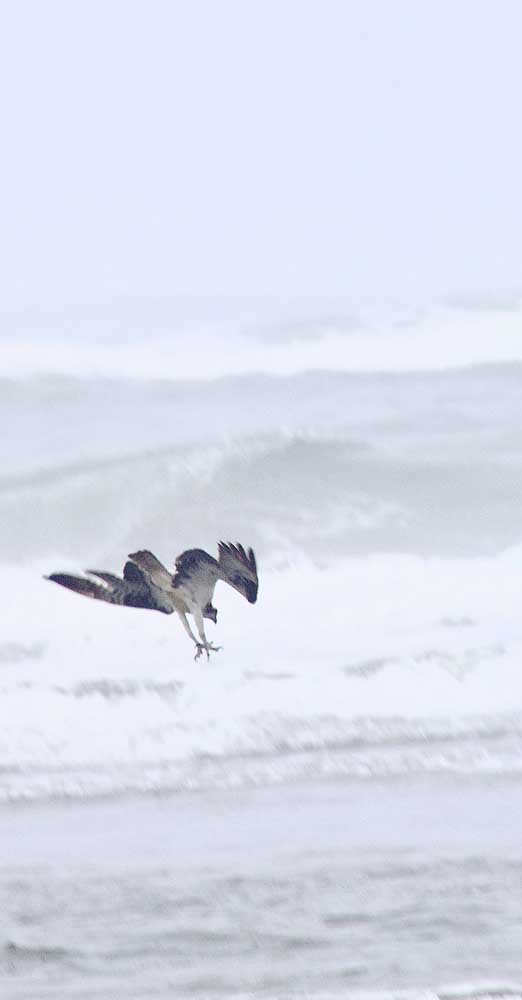Birding: Fish hawk or fish eagle or… osprey!
Published 1:48 pm Thursday, September 12, 2024

- The osprey dives feet first (unique among raptors) into the water to grasp prey.
The other day I was accompanied by a loud, forlorn, sounding scream as I walked gingerly through our wetland to the shores of Willapa Bay. Looking up in the direction of the scream revealed a large bird sitting at the top of a snag. Its feathers were fluffy-looking, not neat and tidy like an adult’s would be, but I knew immediately it was an osprey.
The osprey is a large raptor that breeds on the peninsula and in the Willapa National Wildlife Refuge. It is about two feet in length and has wingspan of between five and six feet. It has a small, white, head and a dark crown. In flight it shows long crooked wings that appear arched with drooping wing tips. Its wing tips are black and look as if they have been dipped in one of those old-fashioned bottles of black ink. When it flies its wings have a prominent characteristic bend or kink. This can be a useful ID marker.
The osprey is a diurnal, fish-eating bird of prey. Most field guides indicate that 99% of its diet consists of live fish, and it is the only bird for which this is true. It has specialized feet for snaring and carrying fish. Barbs on the feet help it to grasp a fish and carry it to its nest. The osprey always carries the fish headfirst so that it is at its aerodynamic best during flight. In addition, it has four toes that are the same length. The tarsi of the toes are reticulate and the talons are rounded. Thus, it can grip a fish with three toes forward and one backward or two forward and two backward. The two and two formation is used most often because it provides the most stable grip during flight.
An interesting feature of our landscape now is the communications tower. Ospreys often find them to be an appealing nesting sight. They usually select a snag, utility pole, fork of a tree or a man-made platform near water. I suspect it likes communication towers because the nest stays relatively more intact from year to year, reducing the amount of annual nest repair and renovation. Snags fall down, and nests may blow off of platforms in a windstorm, but the communication tower has supports that keep the osprey’s building materials — such as sticks, driftwood and seaweed — from being blown away. In addition, it is as high in the air as its usual choices.
The osprey is unusual for three reasons. First it is the only bird whose diet consists mainly of live fish. Secondly, it hovers over the water and dives feet first (unique among raptors) to grasp prey. Thirdly, it is widely distributed throughout the world. It is found on very continent except for Antarctica. In our area, the osprey is common except in fall and winter. In the past an active nest could be seen at Black Lake atop a shoreline tree and on the communication tower across the road from Black Lake. Another communication tower north of Long Beach on the main highway can also be seen from the ocean beach. The last time I checked, it appeared as though a youngster was sitting up tall in the communication tower nest. If so, it was probably waiting for a snack! This year an active nest in Hines marsh was still going strong the first week of September. Almost every day in late August an adult was seen flying in with a fish in its talons for its hungry chick. It dropped the tasty meal in the nest and the chick attacked the goodie like there was no tomorrow.
Snags abound and communication towers are present on the long Beach Peninsula and in various other locations in Pacific County. Look up high! You may see one of our osprey’s beautiful, large, bulky, stick nests. The young will have fledged by now, but some may be still hanging around sitting atop an old nearby snag screaming for food. It is likely hoping its parents are still in the area and that they will continue to bring it sustenance. The screaming mimi is still here in the wetland area sitting like a bird in the wilderness waiting for something to eat.
Happy birding!









